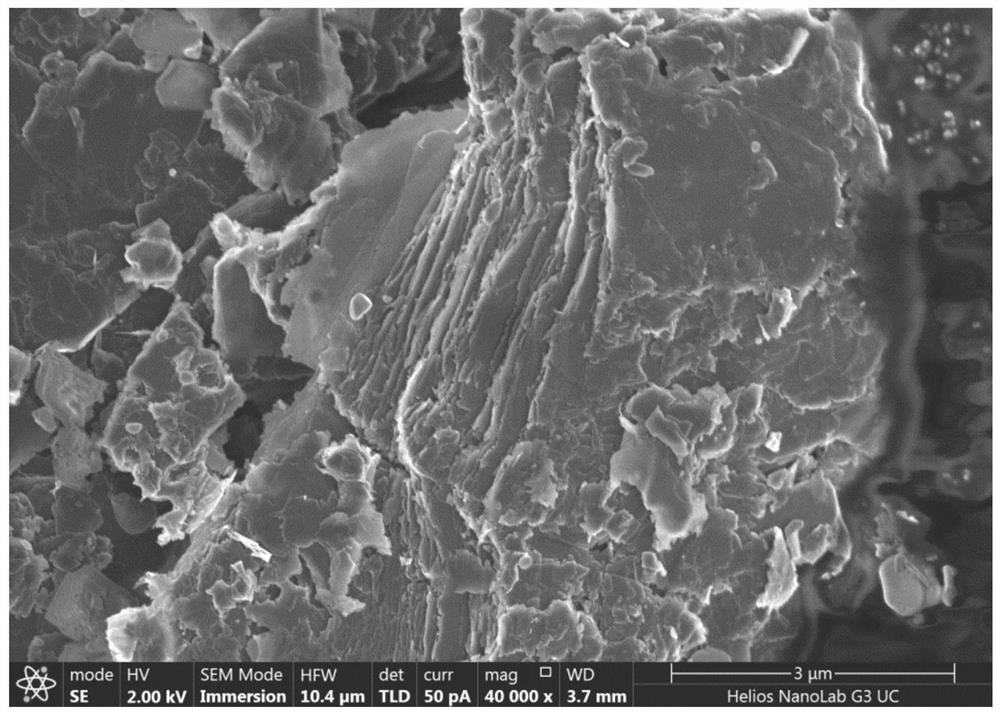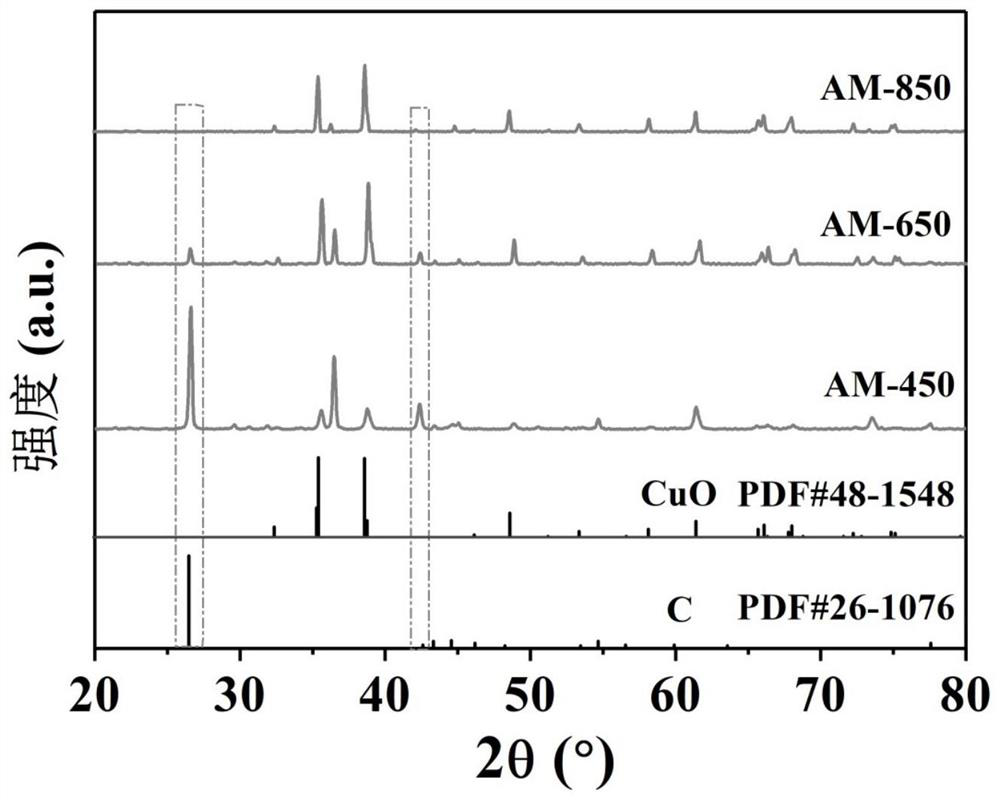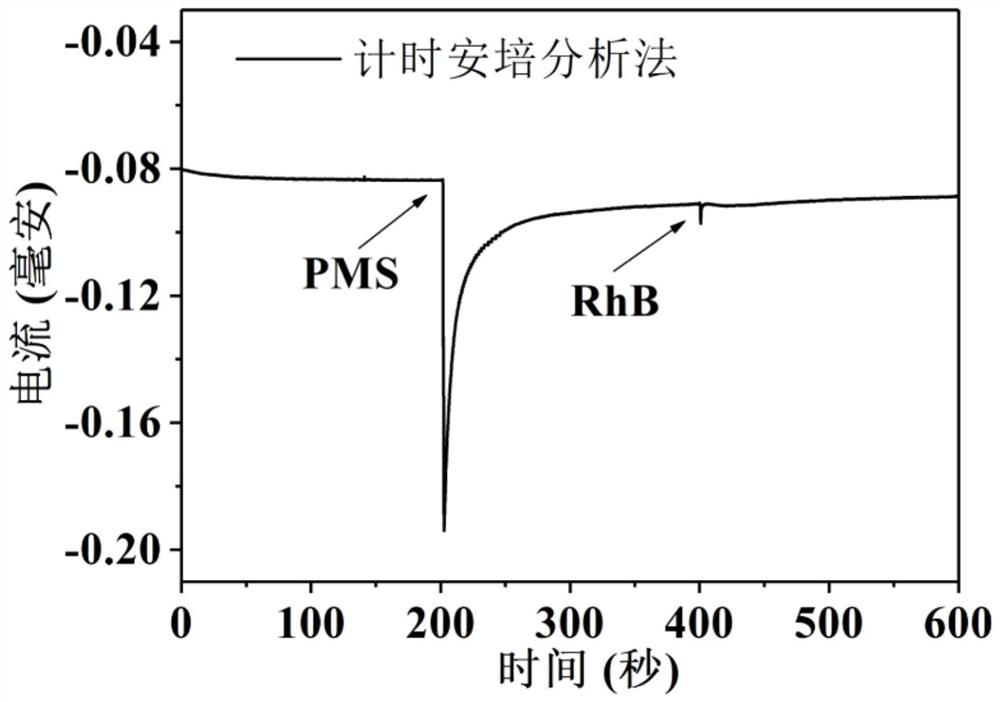Method for removing organic pollutants in water
A technology for organic pollutants and water bodies, applied in the direction of water pollutants, water/sewage treatment, chemical instruments and methods, etc., can solve the problems of high cost, many synthesis steps, etc., and achieve convenient operation, simple process, and easy industrial utilization Effect
- Summary
- Abstract
- Description
- Claims
- Application Information
AI Technical Summary
Problems solved by technology
Method used
Image
Examples
Embodiment 1
[0043] A method for removing organic pollutants in a water body, specifically utilizing a catalyst activated permonosulfate prepared by calcining waste lithium battery anode materials to degrade rhodamine B wastewater, comprising the following steps:
[0044] Take by weighing the catalyst (AM-450, AM-650, AM-850) that makes under the different calcining temperature conditions of 30mg, join respectively in the rhodamine B waste water (the pH value of this waste water is 3.48) of 100mL, 20mg / L, Stir for 5 minutes, mix well, add permonosulfate, wherein the concentration of permonosulfate (potassium hydrogen persulfate) in the system is 0.5mM, carry out degradation reaction for 13min, and complete the removal of rhodamine B in wastewater.
[0045] PMS group: without adding any catalyst, other conditions are the same.
[0046] AM-650 group: without adding permonosulfate, other conditions are the same.
[0047] In the present embodiment, the catalyst (AM-650) that adopts is prepare...
Embodiment 2
[0059] A method for removing organic pollutants in a water body, specifically utilizing a catalyst activated permonosulfate prepared by calcining waste lithium battery anode materials to degrade rhodamine B wastewater, comprising the following steps:
[0060] Take by weighing 6 parts of the catalyst (AM-650) that makes in the embodiment 1, each 30mg, join respectively the rhodamine B waste water that pH value is 3,3.48,5,7,9,11 (the volume of these waste waters is 100mL, the initial concentration is 20mg / L), stir 5min, mix evenly, add permonosulfate (potassium hydrogen persulfate), wherein the concentration of permonosulfate in the system is 0.5mM, carry out the degradation reaction for 13min, complete the Rhodamine B removal from wastewater.
[0061] During the degradation reaction, take 4mL samples with a syringe every 2 minutes in a 5mL centrifuge tube (adding 1mL of methanol quencher in advance to terminate the reaction), and measure the concentration of all samples with u...
Embodiment 3
[0066] A method for removing organic pollutants in a water body, specifically utilizing a catalyst activated permonosulfate prepared by calcining waste lithium battery anode materials to degrade rhodamine B wastewater, comprising the following steps:
[0067] Take by weighing 4 parts of the catalyst (AM-650) that makes in the embodiment 1, each 30mg, add respectively to the deionized water that contains Rhodamine B, tap water, river water (Xiangjiang, Changsha City) and lake water (Taozi Lake, Changsha City) ( The volume of these wastewaters is 100mL, the initial concentration is 20mg / L, and the pH value is 3.48, 6.62, 7.31, 7.85) in turn, stir for 5min, mix well, add permonosulfate (potassium hydrogen persulfate), and the system The concentration of the peroxomonosulfate is 0.5mM, and the degradation reaction is carried out for 13 minutes to complete the removal of rhodamine B in the wastewater.
[0068] During the degradation reaction, take 4mL samples with a syringe every 2...
PUM
 Login to View More
Login to View More Abstract
Description
Claims
Application Information
 Login to View More
Login to View More - R&D
- Intellectual Property
- Life Sciences
- Materials
- Tech Scout
- Unparalleled Data Quality
- Higher Quality Content
- 60% Fewer Hallucinations
Browse by: Latest US Patents, China's latest patents, Technical Efficacy Thesaurus, Application Domain, Technology Topic, Popular Technical Reports.
© 2025 PatSnap. All rights reserved.Legal|Privacy policy|Modern Slavery Act Transparency Statement|Sitemap|About US| Contact US: help@patsnap.com



